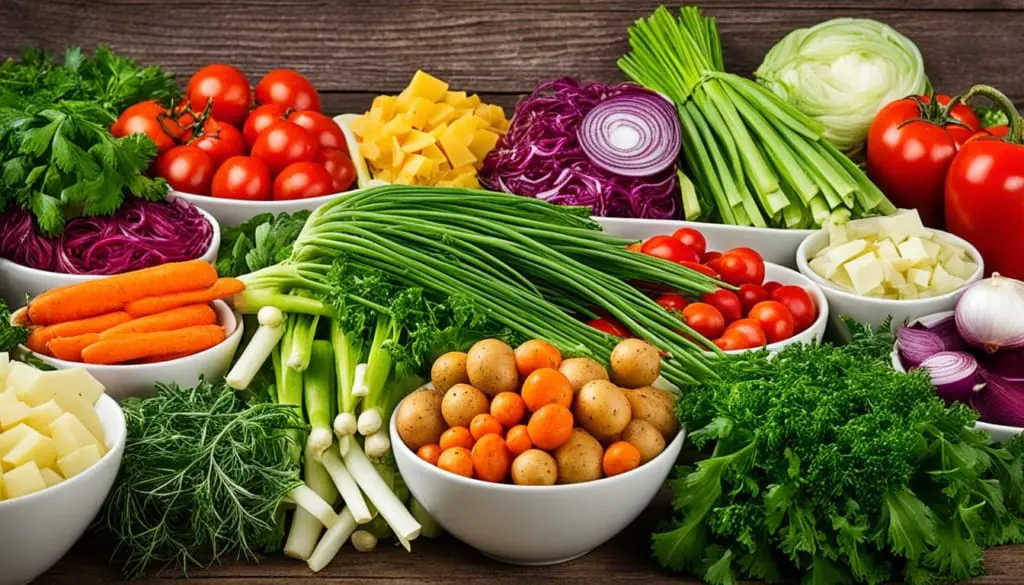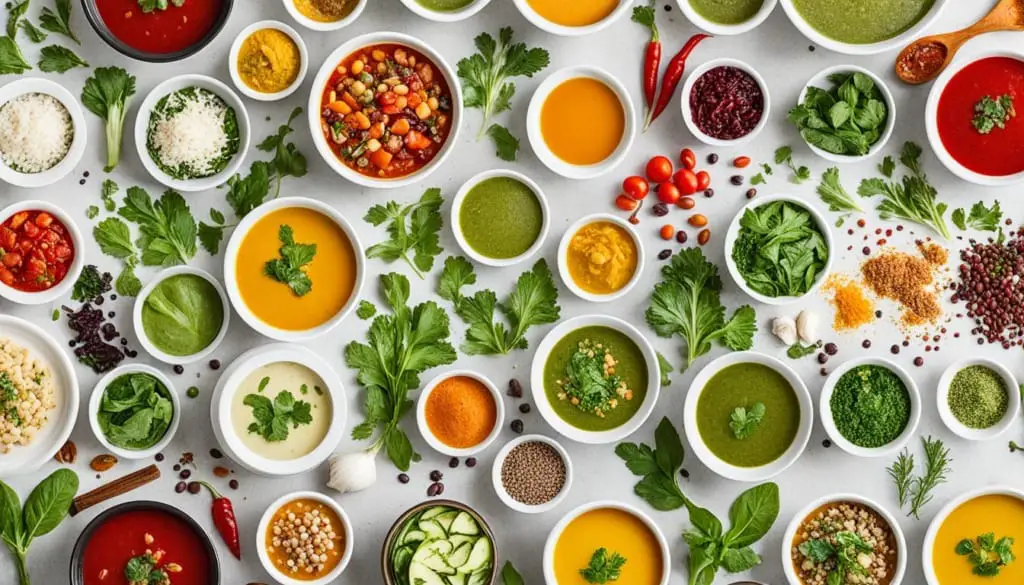What is soup, if not a universal remedy for the soul, enjoyed in many forms around the world? From the soothing chicken noodle soup to the hearty tomato bisque, soup is a versatile meal that can be tailored to any taste or dietary need.
In this article, we’ll explore what defines soup, its key ingredients, the different variations you can enjoy, and the nutritional value it offers. Whether you’re looking for a simple broth or a thick, creamy chowder, there’s a soup out there for everyone.
What Is Soup?
At its core, soup is a liquid dish that’s usually made by boiling ingredients like meat, vegetables, and spices in water or stock. This process blends the flavors and nutrients, creating a wholesome and satisfying meal.
Soups can be thick or thin, range from creamy to brothy, and be served hot or cold, depending on the recipe. They’re a staple in many cultures due to their versatility and the ease of adding a variety of nutrients to a single dish.
Related Article: Now that you know what soup is, you’re probably wondering how it differs from stew. For a deeper look at the differences between soup and stew, see our article on “What is the Difference Between Soup and Stew.”
Soup Essentials: Key Ingredients
Soup is much more than a liquid meal; it’s a crafted blend of essential components that transform it into a rich culinary experience. Here’s a breakdown of what goes into making a great soup:
- Broth or Stock: This is the starting point for most soups. Broth is made by simmering meats, poultry, or vegetables until their flavors meld into a light, tasty liquid. Stock, which includes bones and a mix of vegetables like carrots, onions, and celery (known as mirepoix), is thicker and forms the backbone of many hearty soups.
- Meats: Beef, chicken, pork, and fish add body and protein, enriching the soup’s texture and nutritional value.
- Vegetables: Carrots, onions, celery, and potatoes offer essential vitamins and texture.
- Grains: Rice, barley, and noodles offer heartiness and sustenance, making the soup more filling.
- Legumes: Beans and lentils bring fiber and density to the mix.
- Seasoning: A thoughtful blend of herbs, spices, and salt can elevate the overall taste and aroma of the soup.
When preparing soup, start with a robust base, choose solid ingredients that enhance flavor and texture, and season thoughtfully. The way these core elements blend together is what makes each bowl of soup unique and satisfying.

Different Types of Soup
From light broths to chilled soups, there’s a soup for every taste and occasion. Knowing about different types of soups can help you appreciate this versatile dish even more.
| Type | Base | Characteristic | Popular Example |
|---|---|---|---|
| Clear Soups | Broth/Consommé | Light and Transparent | Chicken Noodle Soup |
| Cream Soups | Cream | Rich and Smooth | Clam Chowder |
| Pureed Soups | Vegetables | Velvety Consistency | Tomato Bisque |
| Chilled Soups | Vegetable Broth/Stock | Cool and Refreshing | Gazpacho |
Clear Soups
Clear soups are all about simplicity and elegance. Made from a clear broth or consommé, they focus on pure, clean flavors. Examples include chicken noodle soup, where the delicate taste of the broth highlights the ingredients.
Thick Soups
This group includes a variety of styles including cream-based and puréed soups. They are thickened with ingredients like cream, purées, or a roux, which adds creaminess and richness. Popular types include chowders, bisques, and potages, each known for their rich texture and full-bodied flavor.
Chilled Soups
Ideal for any season, chilled soups like gazpacho or vichyssoise provide a refreshing twist on traditional hot soup. They are perfect as a light meal or an appetizer during warmer weather.
Nutritional Value of Soups in Your Diet
Soups are not just comforting; they’re also packed with nutrients that are good for your body and heart. A bowl of soup can be both warming and health-boosting with the right ingredients.

For example, broth-based soups are light yet nutrient-rich. They are made by simmering meats and vegetables, a process that infuses the soup with essential vitamins and minerals. This makes them a great option for staying hydrated, which is perfect after exercising or when you’re sick.
Protein-rich soups, loaded with beans, lentils, meats, and vegetables, are excellent for making you feel full while supporting muscle health. These ingredients add fiber and protein, helping you feel satisfied and aiding in digestion.
The Calorie Content of Popular Soups
If you’re keeping an eye on your calorie intake, many soups are surprisingly low in calories. Here’s a quick look at the calorie content of some popular soups.
| Soup | Major Nutrients | Calories (per serving) | Protein Content | Fiber Content |
|---|---|---|---|---|
| Chicken Noodle Soup | Vitamins A and C, Selenium, Collagen | 150 | 12g | 1.5g |
| Vegetable Bean Soup | Dietary Fiber, Iron, Potassium | 200 | 8g | 12g |
| Beef Barley Soup | Zinc, Niacin, Vitamin B12 | 220 | 16g | 4g |
| Lentil Soup | Folate, Manganese, Thiamin | 180 | 11g | 15g |
| Tomato Soup | Lycopene, Vitamin C and K | 90 | 2g | 2g |
International Soups and Global Flavors
Every region has its signature soup, reflecting local tastes and ingredients. Each spoonful is a journey to different cultures and traditions. Let’s explore some traditional soups that have been warming hearts worldwide.
Asia
Asia’s soups are as diverse as the continent itself. For instance, Thailand’s Tom Yum is famously spicy and aromatic. Japan’s miso soup offers a deep umami flavor. Vietnam’s Pho is a comforting broth filled with noodles, vegetables, and herbs, showcasing the fresh and vibrant flavors of Vietnamese cuisine.
Europe
European soups often feature robust and hearty ingredients. France’s onion soup, topped with melty cheese, is a bistro favorite. Spain’s Gazpacho offers a refreshing, cool taste, perfect for hot days. Italy’s Minestrone is a thick, veggie-packed soup that embodies rustic Italian cooking.
South America and Africa
In South America and Africa, soups are unique and full of character. South America’s Caldo Verde, with its blend of kale and sausage, is a comforting staple. From Africa, Nigeria’s Egusi soup is rich with colorful ingredients like melon seeds and greens, offering a taste of Nigerian culinary tradition.

The Art of Soup Pairing with Meals
Master the art of soup pairing to elevate any meal. Think of soup not just as a starter but as a key component that enhances the whole dining experience. A well-chosen soup can complement and balance the flavors and textures of your main dishes.
For example, pairing a creamy soup with a crisp salad can create a satisfying contrast, where the richness of the soup balances the fresh crunch of the salad. Similarly, a light broth can cut through the richness of a creamy dressing, starting your meal on a high note.
Here’s a simple guide to help you match soups and meals:
| Soup | Complementary Meal | Notes |
|---|---|---|
| Tomato Basil Soup | Grilled Cheese Sandwich | A classic duo for a comforting meal |
| French Onion Soup | Beef Roast | A savory soup to complement the richness of beef |
| Chilled Gazpacho | Seafood Paella | Refreshingly light start to a flavorful seafood dish |
| Butternut Squash Soup | Arugula and Pomegranate Salad | The sweetness of the soup pairs with the salad’s tangy taste |
| Miso Soup | Sushi or Sashimi | The umami flavor of miso sets the stage for delicate fish |
Enhancing Soup Flavors
Making great soup is more than just tossing ingredients into a pot. It involves choosing the right herbs, spices, and seasonings. In this part, we’ll teach you how to pick these flavor boosters and explain why cooking time matters for unlocking their full taste.
Herbs, Spices, and Seasonings for Soups
To enhance your soup, keep a well-stocked pantry. Essential herbs like thyme, basil, and cilantro, and spices such as cumin, paprika, and turmeric can dramatically improve your soup’s flavor.
It’s all about finding the right balance: strong spices go well with bold flavors, while lighter herbs are perfect for more delicate soups. Remember, flavor isn’t just about taste; aroma plays a significant role too. Let your nose guide you in mixing seasonings that smell and taste good together.

The Impact of Cooking Times on Flavor
The cooking time is critical for developing deep, rich flavors in soups. Slow cooking allows herbs and spices to fully release their flavors and aromas into the broth.
Thus, it’s important to be patient; the longer the cooking, the more integrated and smooth the flavors become. However, keep an eye on your ingredients, as longer cooking times can also soften them considerably. By managing the cooking time, you can ensure your soup achieves the perfect balance of flavor and texture.
FAQ
What are the health benefits of eating soup?
Soup is a great way to consume a concentrated amount of vitamins and minerals because the cooking process often preserves the nutrients of fresh ingredients. Soups that are broth-based are hydrating and low in calories, making them a healthy choice for maintaining weight and improving digestion.
Do soups have a place in contemporary restrictive diets like vegan or keto?
Absolutely! Soups are incredibly versatile and can be adapted to fit nearly any diet, including vegan and keto. There are countless recipes that cater to these dietary restrictions, offering delicious and nutritious options that don’t compromise on taste or satisfaction.
How do I choose a quality store-bought soup?
When choosing store-bought soup, read its label well. Choose soups with few, known ingredients, low in sodium, and without added chemicals. Look for a good mix of protein, fiber, vitamins, and minerals. The brand’s reputation for quality and use of good ingredients matters too.
Can soup be a complete meal?
Yes, soup can certainly be a complete meal. To make a soup filling and balanced, include a variety of ingredients such as protein (meat or beans), vegetables, and starch like rice or potatoes. This combination ensures you get a good mix of nutrients, making the soup a satisfying meal on its own.
Is it better to simmer soup covered or uncovered?
Simmering soup uncovered can help reduce the liquid and intensify the flavors, which is great for thicker, more robust soups. Covering the soup helps to retain all the liquid and keep all the flavors light and subtle, which is ideal for more delicate soups. It also helps to cook the ingredients more evenly and quickly. Choose based on the outcome you desire for your soup.

